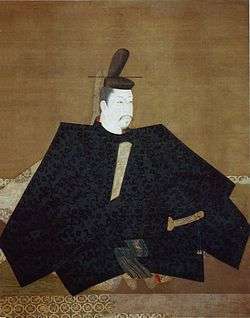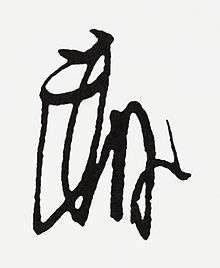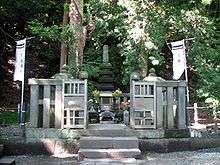Minamoto no Yoritomo
Minamoto no Yoritomo (源 頼朝, May 9, 1147 – February 9, 1199) was the founder and the first shōgun of the Kamakura shogunate of Japan. He ruled from 1192 until 1199.[1] His Buddhist name was Bukōshōgendaizenmon (武皇嘯原大禅門).
Minamoto no Yoritomo 源頼朝 | |
|---|---|
 Portrait of Yoritomo, copy of the 1179 original hanging scroll, attributed to Fujiwara Takanobu. Color on silk. In 1995 Michio Yonekura argued that this portrait is not of Yoritomo but of Ashikaga Tadayoshi. | |
| Shōgun | |
| In office 1192–1199 | |
| Monarch | Go-Toba |
| Preceded by | Heian period |
| Succeeded by | Minamoto no Yoriie |
| Personal details | |
| Born | May 9, 1147 Atsuta, Owari Province |
| Died | February 9, 1199 (aged 52) Kamakura |
| Spouse(s) | Hōjō Masako |
| Children |
|
| Father | Minamoto no Yoshitomo |
Early life
Yoritomo was the third son of Minamoto no Yoshitomo, heir of the Minamoto (Seiwa Genji) clan, and his official wife, Urahime, was a daughter of Fujiwara no Suenori, who was a member of the illustrious Fujiwara clan. Yoritomo was born in the family villa in Atsuta in Nagoya, Owari Province[2][3][4] (present-day Seigan-ji). At that time Yoritomo's grandfather Minamoto no Tameyoshi was the head of the Minamoto. Like Benkei, his childhood name was Oniwakamaru (鬼武丸). He was a descendant of the Emperor Seiwa.[5]
In 1156, factional divisions in the court erupted into open warfare within the capital. The cloistered Emperor Toba and his son Emperor Go-Shirakawa sided with the son of Fujiwara regent Fujiwara no Tadazane, Fujiwara no Tadamichi as well as Taira no Kiyomori (a member of the Taira clan), while Cloistered Emperor Sutoku sided with Tadazane's younger son, Fujiwara no Yorinaga. This is known as the Hōgen Rebellion.[6]:210–211, 255
The Seiwa Genji were split. The head of the clan, Tameyoshi, sided with Sutoku; his son, Yoshitomo, sided with Toba and Go-Shirakawa, as well as Kiyomori. In the end, the supporters of Go-Shirakawa won the civil war, thus ensuring victory for Yoshitomo and Kiyomori. Sutoku was placed under house arrest, and Yorinaga was fatally wounded in battle. Tameyoshi was executed, even after numerous pleas from Yoshitomo. Nonetheless, Go-Shirakawa and Kiyomori were ruthless, and Yoshitomo found himself as the head of the Minamoto clan, while Yoritomo became the heir.[6]
Yoritomo and the Minamoto clan descended from the imperial family on his father's side. Nonetheless, in Kyoto, the Taira clan, now under the leadership of Kiyomori, and the Minamoto clan, under the leadership of Yoshitomo, began to factionalize again.[6]:239–241, 256–257
Kiyomori was supported by Fujiwara no Michinori (also known as Shinzei), while Yoshitomo was supported by Fujiwara no Nobuyori. This was known as the Heiji Rebellion (January–February 1160). The ex-Emperor's and Shinzei's mansions were burned, while Shinzei was captured and decapitated. Nonetheless, the Minamoto were not well prepared, and the Taira took control of Kyoto. Yoshitomo fled the capital but was later betrayed and executed by a retainer.[6]
In the aftermath, harsh terms were imposed on the Minamoto and their allies. Only Yoshitomo's three young boys remained alive, so that Kiyomori and the Taira clan were now the undisputed leaders of Japan.[6]:258–260 Yoritomo, the new head of the Minamoto, was exiled. Yoritomo was not executed by Kiyomori because of pleas from Kiyomori's stepmother. Yoritomo's brothers, Minamoto no Noriyori and Minamoto no Yoshitsune were also allowed to live.[7]
Yoritomo grew up in exile. He married into the Hōjō clan, led by Hōjō Tokimasa, marrying Tokimasa's daughter, Hōjō Masako.[7]:147[6]:371 Meanwhile, he was notified of events in Kyoto thanks to helpful friends. Soon enough, Yoritomo's passive exile was to be over.[8]
Family
- Father: Minamoto no Yoshitomo
- Mother: Yura Gozen (d. 1159), daughter of Fujiwara no Suenori
- Siblings:
- Half-siblings:
- Ano Zenjo (1153–1203)
- Gien (1155–1181)
- Minamoto no Yoshitsune
- Minamoto no Noriyori
- Minamoto no Tomonaga
- Minamoto no Yoshihira
- Natural siblings:
- Bomon-hime (d. 1190) married Ichijō Yoshiyasu
- Minamoto no Mareyoshi (1152–1180)
- Half-siblings:
- Wife: Hōjō Masako
- Concubines:
- Daishin no Tsubone
- Kame no Mae
- Children:
- Sentsurumaru (1167–1169), son of Yoritomo with Yaehime, daughter of Itō Sukechika later was killed by Sukechika.
- Minamoto no Yoriie by Masako
- Minamoto no Sanetomo by Masako
- O-hime (1178–1197) married to Minamoto no Yoshitaka by Masako
- Otohime (1186–1199) by Masako
- Jogyo (1186–1231) by Daishin no Tsubone
Call to arms and the Gempei War (1180–1185)

In 1180, Prince Mochihito, a son of Cloistered Emperor Go-Shirakawa, humiliated by the Taira because of the Taira-backed accession to the throne by his nephew, Emperor Antoku (who was half-Taira) made a national call to arms of the Minamoto clan all over Japan to rebel against the Taira. Yoritomo took part in this, especially after things escalated between the Taira and Minamoto after the death of Minamoto no Yorimasa and Prince Mochihito himself.[6]:278–281, 291
Yoritomo set himself up as the rightful heir of the Minamoto clan, and he set up a capital in Kamakura to the east. Not all Minamoto thought of Yoritomo as rightful heir. His uncle Minamoto no Yukiie and his cousin Minamoto no Yoshinaka conspired against him.[6]:296
In September 1180, Yoritomo was defeated at the Battle of Ishibashiyama, his first major battle, when Ōba Kagechika led a rapid night attack.[9] After losing a battle with the Heike clan at Mt. Ishibashiyama in 1180, Minamoto no Yoritomo fled into the Hakone mountains, stayed in Yugawara, then escaped From Manazuru-Iwa to Awa (south of present-day Chiba). Yoritomo spent the next six months raising a new army.[6]:289–291
In 1181, Taira no Kiyomori died, and the Taira clan was now led by Taira no Munemori.[6]:287 Munemori took a much more aggressive policy against the Minamoto, and attacked Minamoto bases from Kyoto in the Genpei War. Nonetheless, Yoritomo was well protected in Kamakura. His brothers Minamoto no Yoshitsune and Minamoto no Noriyori defeated the Taira in several key battles, but they could not stop Minamoto no Yoshinaka, Yoritomo's rival, from entering Kyoto in 1183 and chasing the Taira south. The Taira took Emperor Antoku with them.[6]:289–305 In 1184, Antoku was displaced by the Minamoto with Emperor Go-Toba as the new emperor.[6]:319
From 1181 to 1184, a de facto truce with the Taira dominated court allowed Yoritomo the time to build an administration of his own, centered on his military headquarters in Kamakura. In the end he triumphed over his rival cousins, who sought to steal from him control of the clan, and over the Taira, who suffered a terrible defeat at the Battle of Dan-no-ura in 1185. Yoritomo thus established the supremacy of the warrior samurai caste and the first bakufu (shogunate) at Kamakura, beginning the feudal age in Japan which lasted until the mid-19th century. Yoritomo practiced shudō with Yoshinao, a member of the Imperial Guard.[10]
Legacy
In December 1185, Go-Shirakawa granted Yoritomo the authority to collect the commissariat tax (the hyoro-mai or levy contribution of rice) and to appoint stewards (jito) and constables (shugo). Thus the Throne "handed to the leader of the military class effective jurisdiction in matters of land tenure and the income derived from agriculture". In the summer of 1189, Yoritomo invaded and subjugated Mutsu Province and Dewa Province. In December 1190 Yoritomo took up residence in his Rokuhara mansion at the capital, the former headquarters of the Taira clan. Upon the death of Go-Shirakawa in the spring of 1192, Go-Toba commissioned Yoritomo Sei-i Tai Shōgun (Generalissimo). Thus a feudal state was now organized in Kamakura while Kyoto was relegated to the role of "national ceremony and ritual".[6]:317–318, 327, 329, 331
In the words of George Bailey Sansom, "Yoritomo was a truly great man … his foresight was remarkable, but so was his practical good sense in setting up machinery to match his own expanding power."[6]:334–335
Yoritomo's wife's family, the Hōjō, took control after his death at Kamakura, maintaining power over the shogunate until 1333, under the title of shikken (regent to the shōgun). One of his brothers-in-law was Ashikaga Yoshikane.[11]
The gorintō (stone pagoda) traditionally believed to be his grave (see article Tomb of Minamoto no Yoritomo) is still maintained today, adjacent to Shirahata Shrine, a short distance from the spot believed to be the site of the so-called Ōkura Bakufu, his shogunate's administrative-governmental offices.
In 1199, he ordained as a Buddhist monk. He died two days later.

Cultural references
He appears as a hero unit in the scenario editor for Age of Empires II: The Age of Kings, and as a hero unit in Total War: Shogun 2
A character named "Yoritomo" appears in Book 6: "The Lords of the Rising Sun" in the Fabled Lands adventure gamebook series, where Yoritomo is the self-proclaimed shōgun and on the verge of war with "Lord Kiyomori".
Eras of Yoritomo's bakufu
The years in which Yoritomo was shōgun are more specifically identified by more than one era name or nengō.
See also
| Wikimedia Commons has media related to Minamoto no Yoritomo. |
- Seiwa Genji
- Eiji Yoshikawa, historical fiction writer
- Battle of Hojuji
Notes
- Nussbaum, Louis-Frédéric. (2005). "Minamoto no Yoritomo" in Japan Encyclopedia, p. 635, p. 635, at Google Books.
- "系図纂要(Keizusanyo)"
- "尾張名所図会(Owarimeishozue)"
- "尾張志(owarishi)"
- https://www.britannica.com/biography/Minamoto-Yoritomo
- Sansom, George (1958). A History of Japan to 1334. Stanford University Press. pp. 210–211, 255–258. ISBN 0804705232.
- Sato, Hiroaki (1995). Legends of the Samurai. Overlook Duckworth. p. 30. ISBN 9781590207307.
- Turnbull, Stephen (1977). The Samurai, A Military History. MacMillan Publishing Co., Inc. pp. 40, 50–51. ISBN 0026205408.
- Turnbull, Stephen (1998). The Samurai Sourcebook. Cassell & Co. p. 200. ISBN 1854095234.
- Homosexuality & Civilization by Louis Crompton. Published by the Belknap Press of Harvard University in 2003. Page 420.
- Nussbaum, "Ashikaga Yoshikane" at p. 56., p. 56, at Google Books
References
- Mass, Jeffrey P. (1999). Yoritomo and the Founding of the First Bakufu: the Origins of Dual Government in Japan. Stanford: Stanford University Press. ISBN 9780804735919; OCLC 41712279
- Nagahara Keiji 永原慶二. Minamoto no Yoritomo 源頼朝. Tokyo: Iwanami-shoten, 1995.
- Naramoto Tatsuya 奈良本辰也, et al. Minamoto no Yoritomo 源頼朝. Tokyo: Shisakusha, 1972.
- Nussbaum, Louis-Frédéric and Käthe Roth. (2005). Japan Encyclopedia. Cambridge: Harvard University Press. ISBN 978-0-674-01753-5; OCLC 58053128
- Titsingh, Isaac. (1834). Nihon Ōdai Ichiran; ou, Annales des empereurs du Japon. Paris: Royal Asiatic Society, Oriental Translation Fund of Great Britain and Ireland. OCLC 5850691.
- Yamaji Aizan 山路愛山. Minamoto no Yoritomo: jidai daihyō Nihon eiyūden 源頼朝: 時代代表日本英雄伝. Tokyo: Heibonsha, 1987.
- Yoshikawa, Eiji. (1989) Yoshikawa Eiji Rekishi Jidai Bunko (Eiji Yoshikawa's Historical Fiction), Vols. 41–42: Minamoto Yoritomo (源頼朝). Tokyo: Kodansha. ISBN 978-4-06-196577-5
External links
- Ōmachi, by the Kamakura Citizen's Net, accessed on September 30, 2008
- Atsuta History Course, (include "Seigan-ji Temple" Birthplace of Minamoto-no Yoritomo)
| Military offices | ||
|---|---|---|
| Shogunate established | Shōgun: Minamoto no Yoritomo 1192–1199 |
Succeeded by Minamoto no Yoriie |
_1.jpg)